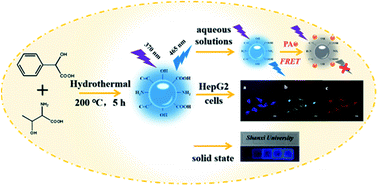An efficient fluorescent nano-sensor of N-doped carbon dots for the determination of 2,4,6-trinitrophenol and other applications†
Abstract
N-Doped carbon dots (CDs) had been simply produced by a one-pot synthesis process using amygdalic acid and threonine. The resulting product was water-soluble and exhibited strong luminescence emission with a fluorescence quantum yield of 19.25%. The emission of CDs was obviously and selectively decreased upon adding 2,4,6-trinitrophenol (TNP). It was proved that the fluorescence resonance energy transfer was the main mechanism for quenching. An efficient fluorescence probe with satisfied sensitivity for TNP determination was found. The range of the linear response for TNP detection was 0.5–40.0 μmol L−1, and the limit of detection was 20 nmol L−1. The content of trace TNP in water samples was successfully detected with this method. The CDs were also applied in HepG2 cell imaging and the fabrication of fluorescent films by dispersing the solid freeze-drying CD (SCD) powder into PMMA, which exhibited some application value in biology and photovoltaics.



 Please wait while we load your content...
Please wait while we load your content...